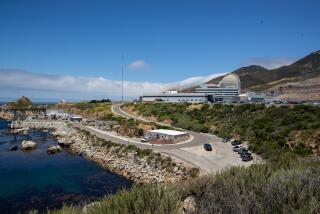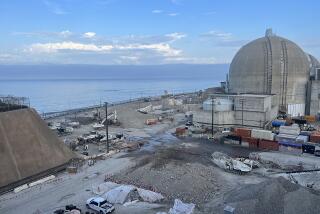Arizona Nuclear Plant Hits Industry Bottom as Deficiencies Persist
PHOENIX — Before the Palo Verde nuclear plant was licensed in 1985, the U.S. nuclear industry built 92 reactors, each one different and needing to go through the detailed, time-consuming and costly scrutiny of regulators.
Palo Verde was the first of what was hoped would be a standardized design that utilities could, in effect, order from a catalogue. That “cookie cutter” approach is used by the French and Japanese nuclear industries.
Palo Verde still is a “state-of-the-art facility,” said NRC regional spokesman Gregory N. Cook. “The plant was built by people who did a superb job. But management did not convert the organization to the kind of staff, the kind of organization you need to operate a nuclear plant in today’s environment.”
As a result, the $9.3-billion plant has been plagued by problems that earned it a ranking as the nation’s 19th worst and worst in terms of management from Public Citizen, a watchdog group. In addition, the Nuclear Regulatory Commission has fined the Arizona Nuclear Power Project $810,000 since 1983 for deficiencies in the plant, which ANPP operates, and sent a special diagnostic team in November. And an industry accreditation board put nine out of 10 training programs on probation in June.
“Palo Verde 1 has fallen to the bottom of the industry,” Joan Claybrook, president of the Critical Mass Energy Project of Public Citizen, a Ralph Nader-founded group, said in May. “It’s time they closed that nuclear lemon down.”
Problems have shut down the three reactors almost as often as they’ve been running and two units have been down since early March, forcing the consortium of utilities that own it to buy power elsewhere during a record heat wave to serve their 4 million customers in four states.
“The mentality of building and the mentality of operating are two totally distinctive things,” William F. Conway, who was lured away from Florida Power & Light Co. in May to oversee Palo Verde, said in June. “It is almost like reading two different prayer books. Operations is another type of religion.”
According to Arizona Corporation Commission records, Unit 1 was in operation 62% of the time in 1986, 49% in 1987, 62% in 1988 and 22% in 1989--not at all since early in March. Unit 2, which came on line in late 1986, was producing power 77% of the time in 1987, 63% in 1988, and less than half of 1989. Unit 3, the newest reactor, was up for 95% of 1988, producing more power than any other unit in the world. But it has been on line only 16% of 1989--not at all since early March.
The 1,270-megawatt, pressurized-water plant’s units have missed a total of 639 days of operation this year. Scheduled refueling and various mechanical problems have kept Units 1 and 3 down since early March, and Unit 2 has been up and down since February.
The NRC fines include $250,000 in September for 13 alleged violations discovered after Unit 3 shut itself down in March. So many things went wrong during the automatic shutdown the NRC ordered a special inspection.
The shutdown occurred because of a power-line failure. Ensuing problems included loss of power to two primary coolant pumps, failure of a fast-transfer system, relief valves that froze and wouldn’t release steam on the non-nuclear side of the plant, and loss of some radiation monitors and emergency lights.
The NRC said in April that equipment failures leading to the shutdown could have been avoided if problems were fixed when they were found, some as long as four years ago: “This event is symptomatic of management’s failure to set a standard which demands that plant problems be recognized and fixed.”
The agency also has complained that top managers didn’t visit critical areas often enough, a problem that is being addressed, Cook said. “They have developed a formal program of getting management on site and into the plant, but as of a couple of months ago the plan hadn’t been fully implemented. We were a little disappointed that it hadn’t gotten farther along.”
Evaluations like the one begun in November, he said, are conducted when “NRC senior management has substantial questions about the overall management of the operation. . . . We are looking toward performance--what works and what doesn’t.” The team’s report is due in about March.
Other fines were $250,000 in December, 1988, over operation and radiation; $100,000 in April, 1988, over engineering and operation; $100,000 in May, 1986, for security problems; $50,000 in October, 1985, for deficiencies in monitoring; and $60,000 in 1983 for lapses in quality assurance and record-keeping. That’s “a fairly poor enforcement record” and “very high” fines, Cook said.
The criteria for Public Citizen’s ratings included such things as forced shutdowns, worker exposure to radiation, violation of NRC regulations, cost of maintenance and scores on annual NRC assessments.
Conway has set in motion a plan for immediate improvements at Palo Verde, said plant spokesman Don Andrews. He brought in new people to raise the level of management experience, began improving accident investigation, issued a set of “standards and expectations” for all employees and moved to “increase the sense of urgency” in responding to problems uncovered by the NRC.
The National Academy for Nuclear Training, which cited lack of attendance among problems when it put plant programs on probation, restored accreditation in October. Only radiation protection training had been deemed adequate.
The NRC has been encouraged by what has happened since Conway took over, Cook said. “You have to expect in dealing with an organization of that size where there have been institutional problems, which certainly there have been, it is going to take time to turn it around.”
In its annual assessment on Nov. 24, the NRC found overall performance to be “satisfactory” and “directed toward safe facility operation.” Performance slipped somewhat in the first six months of the reporting period ending Oct. 31 but showed improvement in the remaining six months, the assessment said.
NRC Regional Administrator J. M. Martin, in a letter accompanying the report, said he expected plant performance to continue improving if management implements planned improvements and corrections. But he cited several areas of “continued weakness,” such as engineering, quality assurance and other “problem-finding” functions.
“The sign of a healthy organization is that they find their own problems,” he said. “They don’t wait for them to be self-revealed, or for them to be found by regulators. What I’m particularly looking for is that they’re finding the bulk of their problems. They aren’t doing that yet.”
Conway said the NRC report was “right on target,” and that he is generally pleased with the progress at Palo Verde. “I’m relatively impatient by nature. I would like for us to be moving faster,” he said. “But I am generally satisfied with where we’re going at this point in time.”
More to Read
Sign up for Essential California
The most important California stories and recommendations in your inbox every morning.
You may occasionally receive promotional content from the Los Angeles Times.










